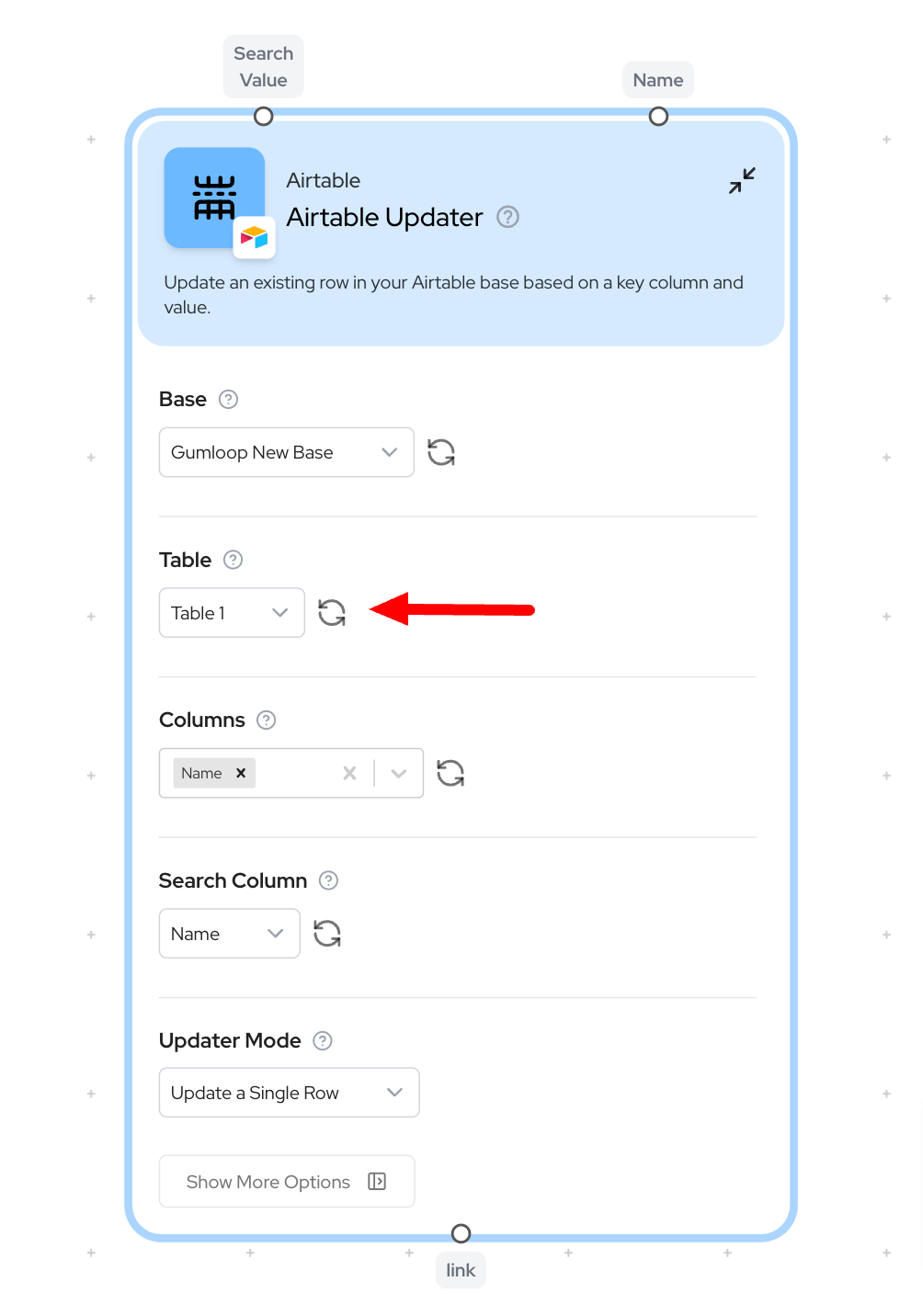Node Inputs
Required Fields
- Base: Choose your Airtable base
- Table: Select the table containing records to update
- Search Column: Choose which column to use for finding records (ideally a unique identifier column)
- Updater Mode: Choose how to update records
- Update a Single Row: Updates one record using text input
- Update Multiple Rows: Updates multiple records using list input
- Search Value: A unique identifier to find the relevant record to update
- For single row: Enter text value
- For multiple rows: Provide list of values
- Update Fields: Select which columns to update with new values
Upsert Option
Under Show More Options, you’ll find a Upsert toggle that enhances update operations.
What is Upsert?
Upsert combines “update” and “insert” functionality in one operation:- If a record matching your Search Value exists, it will be updated
- If no matching record is found, a new row will be created automatically
New rows are added at the end of the table
When to Use Upsert
- Updating records that may not exist yet
- Simplifying flows that would otherwise require conditional logic
Refreshing Field Options
Important: If you modify field names in your Airtable base, you must refresh the node’s field data in Gumloop to see these changes.

- Click the refresh icon (🔄) next to the Table dropdown
- This will update the available field inputs to match your current Airtable table structure
- You’ll need to reconnect any node outputs to fields that have been renamed
- After adding new fields to your Airtable table
- After renaming existing fields in your table
- After deleting fields that are no longer needed
- When new fields in your table don’t appear as inputs in the node
Node Output
- Link to your Airtable base after successful update
- Any error messages if the operation fails
Understanding Search Column and Search Value
The “Search Column” and “Search Value” fields work together to find the specific record(s) you want to update in your Airtable table.How It Works
Think of these fields as creating a filter for your Airtable records:- Search Column: The column you’ll use to identify records (like using a person’s email to find their record)
- Search Value: The specific value to look for in that column (like “[email protected]”)
Example: Customer Database Update
Let’s say you have an Airtable with customer information:| Customer ID | Name | Status | Last Contact | |
|---|---|---|---|---|
| CUST-001 | John Doe | [email protected] | Active | 2023-12-15 |
| CUST-002 | Jane Smith | [email protected] | Inactive | 2023-11-30 |
| CUST-003 | Alex Johnson | [email protected] | Pending | 2024-01-05 |
- Search Column: Choose “Email” (since email addresses are unique)
- Search Value: Enter “[email protected]”
- Update Fields: Connect “Status” to a node that outputs “Active”
- Search the “Email” column for “[email protected]”
- Find Jane’s record
- Update only her “Status” field to “Active”
- Leave all other fields and records unchanged
Multiple Row Updates
For updating several records at once:- Updater Mode: Set to “Update Multiple Rows”
- Search Column: “Customer ID”
- Search Value: Connect to a list like: [“CUST-001”, “CUST-003”]
- Update Fields: Connect “Status” to a list like: [“Premium”, “Premium”]
Important Tips
- Choose Unique Identifiers: When possible, use columns with unique values (IDs, emails)
- Exact Matching: Search values must match exactly (including case)
- No Records Found: If no matching records are found, the node will error out
- Multiple Matches: If multiple records match your search value, the first instance is updated
Node Functionality
The Airtable Updater node modifies existing records in your Airtable bases:- Finds records using exact value matching
- Supports single or multiple record updates
- Maintains secure authentication through Gumloop
- Linked Record Support
Linked Record Support
The node supports creating linked records between tables in Airtable. This allows you to establish relationships between records in different tables.Key Components
- Primary Table: Contains the original records to link from
- Linked Table: The table you want to link to
- Link Field: Column in Airtable with type ‘Link to another record’
How It Works
- The Link Field appears as a regular input in your node configuration
- It accepts record values from the Primary Table to create links
- The record value should ideally be the primary field from your Primary Table
- If using a non-primary field value, a new record will be created in the Primary Table first
- Works seamlessly with Airtable Reader node outputs
Example of Linking Records: Project Tasks and Assignees
Behavior
- If Team Member Email exists:
- Creates link to existing team member
- No new record created
- If Email doesn’t exist:
- Creates new record in Team Members table
- Then creates the link
Example Workflows
1. Update Lead Status
2. Enrich Company Data
3. Process Support Tickets
4. Content Status Updates
Best Practices
Updater Mode Selection
-
Use “Update a Single Row” when:
- Processing one record at a time
- Working with single text input/output
- Needing precise control over updates
-
Use “Update Multiple Rows” when:
- Processing batches of records
- Working with List type input/outputs
- Performing bulk updates
Important Notes
Authentication
- Set up Airtable credentials in Gumloop Credentials
- Ensure proper base and table permissions
- For creating new records, use the Airtable Writer node instead
- After modifying field names in your Airtable table, click the refresh button (🔄) next to the Table dropdown to update the available field inputs in Gumloop

